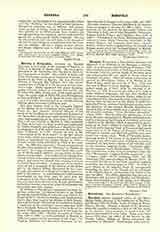

Hersfeld, ancient imperial abbey of the Benedictine Order, situated at the confluence of the Geisa and Haune with the Fulda, in the Province of Hesse-Nassau, Prussia. Sturmi, a disciple of St. Boniface, originally founded a monastery here in 742, but, owing to its position being exposed to attacks from the Saxons, he transferred it to Fulda. Some years later (about 768) after the defeat of the Saxons by the Franks, Lullus, Bishop of Mainz, refounded the monastery at Hersfeld. Charlemagne (who had recently succeeded to the crown) and other benefactors provided endowments, and Pope Stephen III granted exemption from episcopal jurisdiction to the house, which soon possessed 1050 hides of land and a community of 150 monks. It became a place of pilgrimage after 780, owing to the bringing thither of the relics of St. Wigbert, and the reputed occurrence of miracles. A valuable library was collected, the annals of the monastery were regularly kept, and it became renowned as a seat of piety and learning. Towards the close of the tenth century Hersfeld suffered from the general decadence of the age, and the monastic discipline became relaxed. Some years later, however, the observance was reformed by St. Gotthard (afterwards Bishop of Hildesheim), and we find members of the community sent out to other houses of the order to carry out in them the work of religious revival.
During the long struggle between the Emperor Henry IV and Pope Gregory VII, Hersfeld espoused the imperial cause. Henry himself visited it not infrequently, sometimes accompanied by his consort; and their son Conrad (who afterwards succeeded to the throne) was born and baptized within the precincts of the abbey. In the last decade of the eleventh century the abbey seems to have been fully restored to papal favor, and it continued to prosper for a long subsequent period. The town of Hersfeld, outside the abbey walls, also grew and flourished, one result of this being that it found itself strong enough to assert its independence of the rule of the monks, and in 1371 formally placed itself under the protection of the Landgraves of Hesse. As time went on the state of the monastery again deteriorated, and in 1513 it was at so low an ebb that the abbot (Wolpert) resigned his office into the hands of Pope Leo X, and the Abbot of Fulda was authorized by the Emperor Maximilian to incorporate the house into his own famous abbey. A melancholy account has come down to us of the condition into which the venerable Abbey of Hersfeld had at this time been allowed to fall. The library was in a state of ruin and decay, many precious volumes had altogether disappeared, and manuscripts containing the archives and records of the house were used in the kennels as litter for the dogs. This forced union between Hersfeld and Fulda lasted little more than two years, and a new Abbot of Hersfeld was chosen. Abbot Krato, who held office in 1517, was in sympathy with Lutheranism, and he swore allegiance to Philip, the Lutheran Landgrave of Hesse, in 1525. The abbey church was consequently closed to Catholic worship, the Holy Sacrifice of the Mass being said only in a chapel within the monastery.
During the remainder of the century the abbey dragged on an inglorious existence, and on the death of the last abbot (Joachim Ro11) in 1606, Otto, hereditary Prince of Hesse, was elected lay administrator. The pope made a fruitless endeavor, after Otto’s death, to replace the abbey under Catholic administration. It continued in the hands of the princely family until about the middle of the seventeenth century, when, after the conclusion of the Treaty of Westphalia, Hersfeld was, as an imperial fief, united to Hesse under the title of a principality. The town of Hersfeld continued to rank as the capital of a principality until 1828. It is now the chief town of a circle in the government district of Kassel, and has a population of nearly 8000, with some important manufactures. The Stadtkirche, dating from about 1300, was restored in 1899, and there is a Rathaus of the sixteenth century. The ruined collegiate church, in the Romanesque style, was built in the early part of the twelfth century, but was destroyed by the French in 1761, in the course of the Seven Years War. Outside the town, of which the old walls are still preserved, are the remains of the once famous monastery, with its extensive surrounding grounds. The “Annales Hersfeldienses” are often cited as sources of medieval German history.
D. O. HUNTER-BLAIR.

